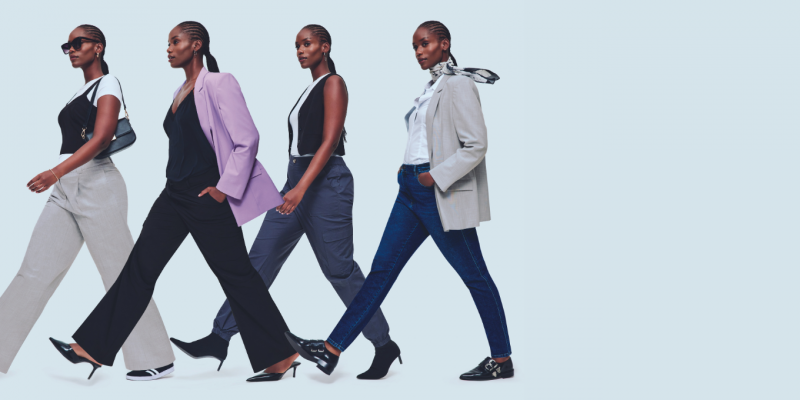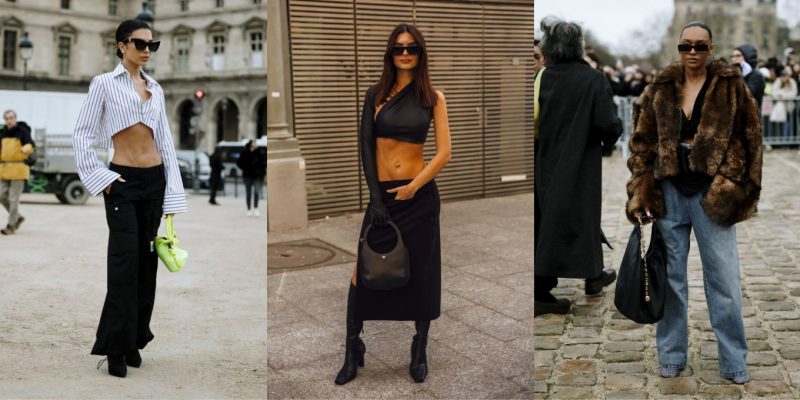Fashion
Lazy luxe
Today's trendy sweatshirt culture solves the problem of how to simultaneously look and feel good.
by : Clara Young- Sep 2nd, 2005

Every day before I sit down to work at my computer, I put on a pair of comfortable grey sweatpants. But while they are cut in the classic slouchy sweatpant style, these are not ordinary jog togs. Made of extremely soft and heavy cotton velvet, the pants have pockets lined with decadent, absinthe-coloured silk satin by Thierry Le Pin. They combine two very different worlds: the plush, cosseted comforts of the five-star luxury hotel and the utilitarian athletic uniform of hooded sweatshirts and jogging suits.
With celebrities running around in Juicy Couture and yoga wear, and with Sweetface pumping out velour sweats, comfiness, it seems, is no longer fashion’s sacrificial lamb. Sweatshirt culture has solved the problem of how to simultaneously look good and feel good, two previously antagonistic states of being.
By cutting their track suits cleverly, as Juicy Couture does, and producing them in yummy colours and luxe fabrics like velour and cashmere, savvy designers have transformed the track suit from sloppy to smart. This was the genius of Marc Jacobs, when he merged downtown hoodies with uptown cashmere. What was then the clash of two worlds is now accepted fashion wisdom. “It began when designers started looking to the streets for inspiration,” says Joan Kaner, Neiman Marcus’fashion director. “Luxury customers were not going to go to the local Army Navy to pick up a sweatshirt. They wanted something with more finish to wear for carpooling, shopping or travelling on an airplane.”
Valerie Steele, director of the Museum at the Fashion Institute of Technology in New York, traces the rise of sweatshirt dressing to “the importance of California style. Juicy Couture has been really important lately in making the sweatshirt an okay and trendy thing to be seen in. And the name is brilliant. With everyone getting more obese, anything that stretches and conceals has potential.”
“Sweats” came into our clothing vernacular in 1925 to describe the grey fleece that provided warmth and absorbed sweat. Champion was the first to produce the hooded reverse-cotton-weave sweatshirts that football players wore on the sidelines. Then, in the 1970s, track suits came in. “Sweatshirts were also associated with surfers, who needed quick warmth when they came
out of the ocean, then skateboarders, then old-school
hip hop culture like Run-D.M.C.,” says Steele. “There were Vivienne Westwood’s Anglomania sweatshirts, Calvin Klein, and Norma Kamali’s sweatshirt collection.”
Of all the designers who have flirted with grey fleece over the years, Norma Kamali is the only one who is synonymous with it. She invented sweatshirt dressing. And now that the New York vintage store Resurrection has persuaded Kamali to sell off her enormous fleece stock, the queen of sweats is back on fashion’s radar. “The sweatshirt collection came out in the late ’70s,” says Kamali. “I was doing a swimwear collection, working on cover-ups. I was a big swimmer, and I always put on a sweatshirt when I got out of the water; I liked the feeling of the sweatshirt soaking up the water. So I bought some grey fleece. At that time, grey fleece was used not just for gym clothes, but for college sweatshirts. I started to do some pieces meant to be cover-ups, and then I thought, ‘Wouldn’t it be great to do a dress or a rah-rah dress or an evening gown?’It was so exciting because I knew that it was the first time anything like this had been done.”
More fashionable comfy on the next page!Kamali’s sweatshirt collection turned out to be prescient. Moderately priced and wittily designed, her sweatshirt blazers, rah-rah skirts and long mermaid skirts raced out of the stores. The collection anticipated the ’80s fitness craze and the scissored sweatshirt tops of the 1983 movie Flashdance. “When the sweatshirt collection came out, it was still very early on. People were starting to work out, but they would be smoking while doing their sit-ups, having a chat and a coffee at the gym,” says Kamali. “It’s not like the way we work out today. But by the early ’80s, once AIDS started to take a lot of lives and rob us of friends, everyone got into fitness; the sweatshirt thing locked in by ’83.”
The humble sweatshirt material itself crops up quite frequently among more experimental designers. Martin Margiela and Bernard Wilhelm have done sweatshirt pieces; Tara Subkoff showed a ruff-necked sweatshirt minidress in her fall 2005 collection; and Alber Elbaz showed a duo of flowing grey jersey sweatshirt dresses n his. Thick and teddy-bear soft, sweatshirting is a challenging material to work with. It is also richly referential, with athletic, blue-collar and street connotations that appeal to concept-minded designers. “Vivienne Westwood has made corseted tops out of sweatshirt material,” says Claire Wilcox, who curated the Vivienne Westwood retrospective at London’s Victoria and Albert Museum last year. “The interesting thing about sweatshirt is that it is a soft material that is structured and active. Vivienne uses fabric in unexpected ways, taking floppy, soft sweatshirt fabric and structuring it with corset under-
boning and low-cut décolletage. She also uses circular cutting, which produces pockets of fabric that stick out from the body. Usually sweatshirt flops down, so she has animated it. She takes sweatshirt and treats it as she would the most expensive silk taffeta.”
The appeal of sweatshirt material lies in its inherent democracy. It is, after all, a cheap, abundant fabric. Price accessibility was part of the political statement Kamali was making when she did her sweatshirt clothes. “At that time, I felt it was important to do fashion at a low price,” she explains. “You could be very adventurous, do fun, new concepts and keep it under $200 so that people could afford to take chances and have fun with their wardrobe.”
Designer Ashish Gupta, a former Toronto resident who recently moved back to London, travels the world in search of vintage sweats for his collections. “I’ve got an enormous room full of sweatshirts; I’m so compulsive,” he says, laughing. “Fashion always comes out of non-fashion, and in that sense sweatshirts are classic, like jeans. I’m fascinated by North American culture, the way they put everything-the messages, the logos-on a sweatshirt. The whole culture can be found on the sweatshirt. What’s nice is to take the sweatshirt and turn it into something really precious.” For his fall 2005 collection, Ashish took apart his best finds, hand-beaded them on wooden frames, recut them for a flattering fit and then reassembled them. His reworked creations glisten with transparent glass beads that sparkle as the wearer moves.
“A lot of new sweatshirts are of quite shabby quality,” says Alfred Tong, a fashion editor at the London-based trend forecasting firm The Future Laboratory. “That’s why a lot of designers are looking at vintage sweatshirts or making them the way they used to be made in the ’40s, with heavy, chunky reverse weave that wears out really nicely. They are going back to the essence of what sweatshirts were in the ’40s and ’50s, made on old looms.” Evidently, not all sweatshirts are created equal, and it is this sweatshirt snobbery that is currently fuelling fetishized street brands like the Japanese A Bathing Ape. But whether sweatshirts are made out of the finest pashmina, the heaviest cotton weave or hand-beaded and appliquéd like an haute-couture gown, sweatshirt dressing is a statement about comfort, and that is why it is here to stay. “When I did sweatshirts, the workplace was starting to look more casual — people on the street and people travelling were starting to look more casual,” says Kamali. “Casual dressing really became more important than specific, more formal ways of dressing. I showed my sweatshirt pieces with sneakers. It was a powerful, revolutionary time for fashion, and it changed the way we dress now.”
Newsletter
Join our mailing list for the latest and biggest in fashion trends, beauty, culture and celebrity.
Read Next

Fashion
H&M's Latest Designer Collab With Rokh Just Dropped (And It's So Good)
We chatted with the emerging designer about the collaboration, his favourite pieces and more.
by : Melissa Fejtek- Apr 18th, 2024

Culture
5 Toronto Restaurants to Celebrate Mother’s Day
Treat your mom right with a meal at any of these amazing restaurants.
by : Rebecca Gao- Apr 18th, 2024

Culture
This Maple Whipped Tofu Toast Is Unreal
Light, fluffy with a touch of zest, this maple syrup-infused toast is a slice of heaven.
by : Margaux Verdier- Apr 9th, 2024




